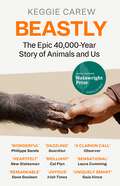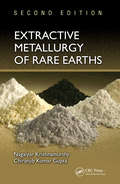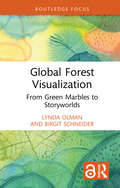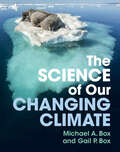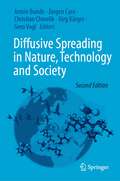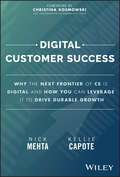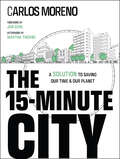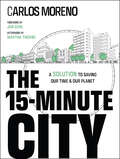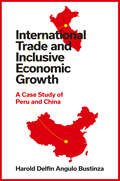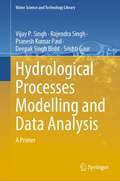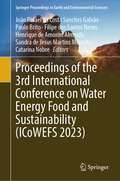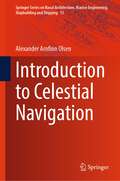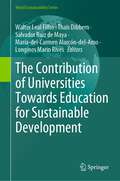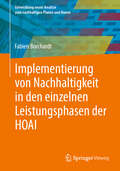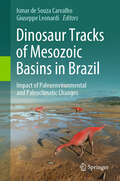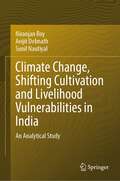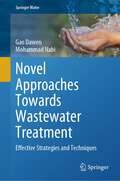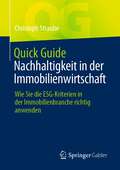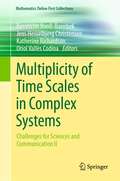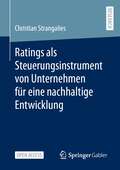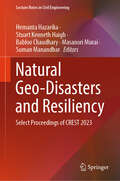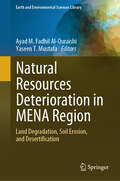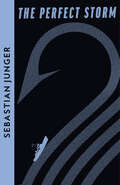- Table View
- List View
Beastly: A New History of Animals and Us
by Keggie CarewSHORTLISTED FOR THE WAINWRIGHT PRIZE FOR CONSERVATION A BOOK OF THE YEAR FOR THE FINANCIAL TIMES, WATERSTONES AND BBC HISTORY MAGAZINE A NEXT BIG IDEA CLUB MUST READ Beastly is the 40,000-year story of our changing kinship with the animal world - from the smallest microbe to the largest creature that ever lived. Exploring this relationship through history, culture, science and inspiring examples, Carew makes the passionate case that animals are the key to the planet's future health, but only if we can save them.
Extractive Metallurgy of Rare Earths
by Nagaiyar Krishnamurthy Chiranjib Kumar GuptaNew Edition Now Covers Recycling, Environmental Issues, and Analytical DeterminationEmploying four decades of experience in the rare metal and rare earths industry, the authors of Extractive Metallurgy of Rare Earths, Second Edition present the entire subject of rare earth elements with depth and accuracy. This second edition updates the most impor
Global Forest Visualization: From Green Marbles to Storyworlds (Routledge Focus on Environment and Sustainability)
by Lynda Olman Birgit SchneiderThis book project examines global forest monitoring as a means to understand the promises and problems of global visualization for climate management.Specifically, the book focuses on Global Forest Watch, the most developed and widely available forest-monitoring platform, created in 1997 by the World Resource Institute. Forest maps are always political as they visualize power relations and form the grid within which forests become commodities. This dislocation of the idea of the forest from its literal roots in the ground has generated problems for forest visualization efforts designed to empower local communities. This book takes a critical humanistic approach to this problem, combining methods from the fields of rhetoric and media studies to suggest solutions to these problems for designers and users of platforms like the Global Forest Watch. To explain why global views of forests can be disempowering, the book relies on biopolitical and rhetorical theories of panopticism and how these views unfold a different violence on different regions of the Earth in relation to colonial history. Using this theoretical framework, the book explains the historical process by which forests came to be classified, quantified, and mapped on a global scale. Interviews with end-users of global forest visualization platforms reveal if and how these platforms support local action. Lastly, the book provides rhetorical solutions to articulate global and local views of forests without reducing one view to the other. These solutions involve looking to forests themselves for clues about how to generate more broadly effective and resilient visualizations.This book will be of great interest to students and scholars of forest studies, climate change, science communication, visualization studies, environmental communication, and environmental conservation.The Open Access version of this book, available at http://www.taylorfrancis.com, has been made available under a Creative Commons [Attribution-Non Commercial-No Derivatives (CC-BY-NC-ND)] 4.0 license.
The Science of Our Changing Climate
by null Michael A. Box null Gail P. BoxThis compelling textbook provides a broad overview of the science underpinning our understanding of our climate, and how it is changing. Presented in clear and accessible language, and requiring only minimal algebra, it enables students to understand how our planet “behaves” under “normal conditions” and how human activity has moved us away from that normal. It walks the student comprehensively through the basic science, including how greenhouse gases absorb radiation and, crucially, a chapter on aerosols, major players in climate change. Diverse case studies and examples illuminate the impact and connections to real world events while review questions and exercises consolidate knowledge. Including the latest results from the IPCC 6th Assessment Report, it concludes by exploring climate modelling, equipping students with an understanding of how to simulate both past climate changes and projections of future climate change. Online resources include lecture slides, solutions and Excel code.
Diffusive Spreading in Nature, Technology and Society
by Armin Bunde Jürgen Caro Christian Chmelik Jörg Kärger Gero VoglWhat do the movements of molecules and the migration of humans have in common? How does the functionality of our brain tissue resemble the flow of traffic in New York City? How can understanding the spread of ideas, rumors, and languages help us tackle the spread a pandemic? This book provides an illuminating look into these seemingly disparate topics by exploring and expertly communicating the fundamental laws that govern the spreading and diffusion of objects. A collection of leading scientists in disciplines as diverse as epidemiology, linguistics, mathematics, and physics discuss various spreading phenomena relevant to their own fields, revealing astonishing similarities and correlations between the objects of study—be they people, particles, or pandemics. This updated and expanded second edition of an award-winning book introduces timely coverage of a subject with the greatest societal impact in recent memory—the global fight against COVID-19. Winner of the 2019Literature Prize of the German Chemical Industry Fund and brainchild of the international and long-running Diffusion Fundamentals conference series, this book targets an interdisciplinary readership, featuring an introductory chapter that sets the stage for the topics discussed throughout. Each chapter provides ample opportunity to whet the appetite of those readers seeking a more in-depth treatment, making the book also useful as supplementary reading in appropriate courses dealing with complex systems, mass transfer, and network theory. Chapter “Neolithic Transitions: Diffusion of People or Diffusion of Culture?” is available open access under a Creative Commons Attribution 4.0 International License via link.springer.com.
Digital Customer Success: Why the Next Frontier of CS is Digital and How You Can Leverage it to Drive Durable Growth
by Nick Mehta Kellie CapoteAutomate your Customer Success efforts to reduce churn and increase profits In Digital Customer Success: The Next Frontier, a team of trailblazing Customer Success professionals and digital entrepreneurs delivers an insightful discussion of the next stage in Customer Success management. In the book, you'll discover how to design and deploy touchless and automated digital interventions that help your software users learn and grow as they use your product and unlock the value trapped within it — without ever needing to reach out to a live Customer Success Manager. The authors provide a detailed “How-To” guide to Digital Customer Success that explains how you can meet the needs of your customers, investors, and team members. You'll explore the basics of the authors' original Digital Customer Success Maturity Model and the core tenets of how to get started. After that, you'll find: Explanations of the ideal organizational structures to enable Digital Customer Success management Case studies and examples from real companies blazing new trails in Customer Success Critical success measurements and metrics you can use to determine if your company is on the right track or if it needs to reorient Perfect for managers, executives, directors, founders, entrepreneurs, and other business leaders involved in the sale of digital and software products, Digital Customer Success is also a can't-miss resource for Customer Success professionals, sales leaders, marketers, product development professionals, and anyone else with a stake in reducing customer churn and increasing revenues.
Digital Customer Success: Why the Next Frontier of CS is Digital and How You Can Leverage it to Drive Durable Growth
by Nick Mehta Kellie CapoteAutomate your Customer Success efforts to reduce churn and increase profits In Digital Customer Success: The Next Frontier, a team of trailblazing Customer Success professionals and digital entrepreneurs delivers an insightful discussion of the next stage in Customer Success management. In the book, you'll discover how to design and deploy touchless and automated digital interventions that help your software users learn and grow as they use your product and unlock the value trapped within it — without ever needing to reach out to a live Customer Success Manager. The authors provide a detailed “How-To” guide to Digital Customer Success that explains how you can meet the needs of your customers, investors, and team members. You'll explore the basics of the authors' original Digital Customer Success Maturity Model and the core tenets of how to get started. After that, you'll find: Explanations of the ideal organizational structures to enable Digital Customer Success management Case studies and examples from real companies blazing new trails in Customer Success Critical success measurements and metrics you can use to determine if your company is on the right track or if it needs to reorient Perfect for managers, executives, directors, founders, entrepreneurs, and other business leaders involved in the sale of digital and software products, Digital Customer Success is also a can't-miss resource for Customer Success professionals, sales leaders, marketers, product development professionals, and anyone else with a stake in reducing customer churn and increasing revenues.
The 15-Minute City: A Solution to Saving Our Time and Our Planet
by Carlos MorenoA fresh and innovative perspective on urban issues and creating sustainable cities In The 15-Minute City: A Solution for Saving Our Time and Our Planet, human city pioneer and international scientific advisor Carlos Moreno delivers an exciting and insightful discussion of the deceptively simple and revolutionary idea that everyday destinations like schools, stores, and offices should only be a short walk or bike ride away from home. This book tells the story of an idea that spread from city to city, describing a new way of looking at living that addresses many of the most intractable challenges of our time. Hundreds of mayors worldwide have already embraced the concept as a way to help recover from the pandemic, and the idea continues to gain speed. You'll learn why more and more cities are planning to make cars far less necessary for contemporary city-dwellers and how they're planning to achieve that goal. You'll also find: Strategies for cities to recover and adapt to benefit residents, saving them precious time Techniques to change the habits of automobile-dependent city residents and maximize social benefits of living in a human-centric city Scientifically developed, research-backed solutions for enduring urban issues and problems Deeply committed to science, progress, and creativity, Moreno presents an essential and timely resource in The 15-Minute City, which will prove invaluable to anyone with an interest in modern and innovative approaches to consistently challenging urban issues that have bedeviled policy makers and city residents since the invention of the car.
The 15-Minute City: A Solution to Saving Our Time and Our Planet
by Carlos MorenoA fresh and innovative perspective on urban issues and creating sustainable cities In The 15-Minute City: A Solution for Saving Our Time and Our Planet, human city pioneer and international scientific advisor Carlos Moreno delivers an exciting and insightful discussion of the deceptively simple and revolutionary idea that everyday destinations like schools, stores, and offices should only be a short walk or bike ride away from home. This book tells the story of an idea that spread from city to city, describing a new way of looking at living that addresses many of the most intractable challenges of our time. Hundreds of mayors worldwide have already embraced the concept as a way to help recover from the pandemic, and the idea continues to gain speed. You'll learn why more and more cities are planning to make cars far less necessary for contemporary city-dwellers and how they're planning to achieve that goal. You'll also find: Strategies for cities to recover and adapt to benefit residents, saving them precious time Techniques to change the habits of automobile-dependent city residents and maximize social benefits of living in a human-centric city Scientifically developed, research-backed solutions for enduring urban issues and problems Deeply committed to science, progress, and creativity, Moreno presents an essential and timely resource in The 15-Minute City, which will prove invaluable to anyone with an interest in modern and innovative approaches to consistently challenging urban issues that have bedeviled policy makers and city residents since the invention of the car.
International Trade and Inclusive Economic Growth: A Case Study of Peru and China
by Harold Delfin Angulo BustinzaExamining economic growth through the lens of poverty, social exclusion, and economic inequality, Harold Delfin Angulo Bustinza offers an econometric analysis of the effects of international trade between Peru and China, which has seen an average annual growth of 22% over the past two decades. China thus plays a key role in Peru's economic growth, whether in imports of primary goods, exports of capital and consumer goods, or direct investment. However, income and wealth inequality in Peru have not improved over the years. Even so, it has been found that growth in international trade between the two countries has the potential to positively benefit Peru’s inclusive economic growth. With global development still on the rise, it is pivotal for us to ensure that all actors of society can benefit from that development, and not just the most privileged. Advocating for the importance of promoting openness in trade, International Trade and Inclusive Economic Growth highlights China and Peru’s unique relationship to prioritize fair and equitable growth for all.
International Trade and Inclusive Economic Growth: A Case Study of Peru and China
by Harold Delfin Angulo BustinzaExamining economic growth through the lens of poverty, social exclusion, and economic inequality, Harold Delfin Angulo Bustinza offers an econometric analysis of the effects of international trade between Peru and China, which has seen an average annual growth of 22% over the past two decades. China thus plays a key role in Peru's economic growth, whether in imports of primary goods, exports of capital and consumer goods, or direct investment. However, income and wealth inequality in Peru have not improved over the years. Even so, it has been found that growth in international trade between the two countries has the potential to positively benefit Peru’s inclusive economic growth. With global development still on the rise, it is pivotal for us to ensure that all actors of society can benefit from that development, and not just the most privileged. Advocating for the importance of promoting openness in trade, International Trade and Inclusive Economic Growth highlights China and Peru’s unique relationship to prioritize fair and equitable growth for all.
Hydrological Processes Modelling and Data Analysis: A Primer (Water Science and Technology Library #127)
by Vijay P. Singh Rajendra Singh Pranesh Kumar Paul Deepak Singh Bisht Srishti GaurThis book provides a state-of-the-art overview of the concepts and methodologies of data and modelling-driven hydrological analyses and their wide range of practical applications. The book is driven by the realisation that science, technology, engineering, and mathematics (STEM) concepts are essential in engineering hydrology to produce well-trained hydrologists. Such hydrologists will be equipped to face future societal challenges that require enhanced information and communication technology tools and integration of technical and non-technical areas. The book contains 12 chapters that introduce the principles of hydrological data analysis and highlight the current and emerging tools and techniques for analysing hydrologic data. The book describes the types of data typically used in hydrological analyses. It highlights the revolutionary technological advancements made toward hydrological data collection, including the use of drones and smartphones. The foremost objective of the book is to present the hydrological data analysis procedures. It explains the steps involved in data analysis for easy understanding of the reader, including students and professionals. This book presents case studies that demonstrate step-by-step procedures involved in typical analysis problems and may guide students and professionals in planning and executing steps to analyse the problem at hand. Case study examples will guide them to understand the intricacies of hydrological data analysis. It provides the readers with a complete package to enrich their understanding of the hydrological data analysis tools and techniques. Subsequently, as well-trained hydrologists, they could execute their learning to meet any specific grand challenge of the twenty-first century.
Proceedings of the 3rd International Conference on Water Energy Food and Sustainability (Springer Proceedings in Earth and Environmental Sciences)
by João Rafael da Costa Sanches Galvão Paulo Brito Filipe dos Santos Neves Henrique de Amorim Almeida Sandra de Jesus Martins Mourato Catarina NobreThis book presents some of the work presented at the 3rd International Conference on Water Energy Food and Sustainability—ICoWEFS 2023, with topics delving into critical global themes. Encompassing four pivotal domains—Water and Circular Economy, Energy, Agrifood, and Sustainability—this book covers cutting-edge research and innovative solutions. Within the ambit of Water and Circular Economy, the discussions span from the sustainable management of water resources, urban and industrial water consumption, to the challenges in governance and the impact of climate change. The Energy section covers chapters on energy production, urban and industrial systems, governance challenges, and the imperative transition toward circular economies. The Agrifood domain probes into sustainable agricultural practices, harnessing smart technologies in farming, climate change's effect on food production, and innovations in food processing. Lastly, the Sustainability segment encompasses a wide array of topics including bioeconomy sustainability, cyber-physical systems, climate change impacts, and resource efficiency, underpinning the urgent need for a holistic approach to global sustainability.
Introduction to Celestial Navigation (Springer Series on Naval Architecture, Marine Engineering, Shipbuilding and Shipping #15)
by Alexander Arnfinn OlsenThis book focuses on Coastal and Ocean Navigation with an emphasis on celestial navigation techniques as a ‘back up’ in the event digital technologies fail.It deals with the main themes and principles of celestial navigation (including time). It covers the syllabus for deck officers working towards the Officer of the Watch (OOW) certificate of competence (COC) awarded by the Maritime and Coastguard Agency (MCA), and for Royal Navy navigation officers working towards achieving the equivalent Navigational Watch Certificate (NWC). The NWC is equivalent to the certificate awarded by the MCA to OOWs in the Merchant Service under the international Standardisation of Training, Certification and Watchkeeping (STCW) agreements. The detailed theory of celestial navigation is provided.
The Contribution of Universities Towards Education for Sustainable Development (World Sustainability Series)
by Walter Leal Filho Thais Dibbern Salvador Ruiz de Maya María-del-Carmen Alarcón-del-Amo Longinos Marin RivesThe book gathers inputs from universities and research organizations working on matters related to sustainable development in a variety of contexts. It also provides a platform for the dissemination of information on the latest initiatives, paving the way for technology transfer and networking. Furthermore, the book intends to provide a fertile basis upon which universities may cooperate more closely in this key area. Universities, as centers of education, research, and innovation, have a unique position and responsibility in promoting sustainability. They can offer degree programs, courses, and workshops focused on sustainability, environmental studies, and related fields, educating students and the wider community about the principles and challenges of sustainability. Also, universities can conduct cutting-edge research to address sustainability challenges, such as climate change, resource depletion, and biodiversity loss. They can develop innovative technologies and solutions that promote sustainable practices in various sectors, including energy, agriculture, transportation, and urban planning. There is a perceived need to better understand and engage universities further on sustainability initiatives. Against this backdrop and in order to facilitate a broad discussion on the contribution of universities toward sustainability, this book is being produced.Last but not least, a further aim of the book is to present methodological approaches and experiences deriving from case studies and projects, which aim to show how sustainability may be incorporated as part of university programs.
Implementierung von Nachhaltigkeit in den einzelnen Leistungsphasen der HOAI (Entwicklung neuer Ansätze zum nachhaltigen Planen und Bauen)
by Fabien BorchardtDas Buch bietet einen allgemeingültigen Leitfaden zur Implementierung von Nachhaltigkeitsaspekten in den einzelnen Leistungsphasen der HOAI. Dieser Leitfaden bezieht sich auf die Planung, Ausführung, Bewirtschaftung und Verwertung eines Neubaus hinsichtlich öffentlicher Gebäude. Die Inhalte und Beiträge des Leitfadens werden durch eine ausführliche Untersuchung des derzeitigen Standes der Technik und der Forschung angefertigt. Dabei werden die derzeitigen Regelwerke bzw. gültigen Standards, Bewertungs- und Zertifizierungssysteme, aktuelle Forschungsarbeiten sowie existierende Leitfäden begutachtet und für die eigene Arbeit bewertet. Der thematische Schwerpunkt dieser Arbeit liegt auf der anschließenden Entwicklung eines Leitfadens, welcher Nachhaltigkeitskriterien für die unterschiedlichen Stakeholder eines öffentlichen Bauvorhabens sowie deren Leistungsphasen gemäß HOAI festlegt. Die Nachhaltigkeitskriterien orientieren sich an der Optimierung der ökologischen, ökonomischen, soziokulturellen und technischen Qualität sowie an der Prozess- und Standortqualität des zu erstellenden Gebäudes. Neben den Leistungsphasen nach HOAI werden ebenso die „Phase 0“ sowie „Phase 10“ betrachtet. Somit soll eine ganzheitliche lebenszyklusorientierte Betrachtung eines Gebäudes durch den Leitfaden ermöglicht werden. Der Leitfaden stellt die allgemeine Vorgehensweise und Methodik zur Implementierung von Nachhaltigkeitsaspekten in der Planung, Ausführung, Bewirtschaftung und Verwertung eines Neubaus dar. Mit Hilfe der Erstellung des allgemeingültigen Leitfadens für öffentliche Bauvorhaben soll eine Grundlage für die Erstellung eines nachhaltigen Neubaus geschaffen werden. Ein abgeschlossenes Bauvorhaben wird mit dem erstellten Leitfaden evaluiert. Hierbei wird auf die Verbesserungspotentiale zur Implementierung weiterer Nachhaltigkeitsaspekte für zukünftige Bauprojekte öffentlicher Auftraggeber eingegangen.
Dinosaur Tracks of Mesozoic Basins in Brazil: Impact of Paleoenvironmental and Paleoclimatic Changes
by Ismar de Souza Carvalho Giuseppe LeonardiThis book presents the diversity of Dinosaur tracks found in Mesozoic basins in Brazil and brings it in a paleoenvironmental context. Each chapter includes information about the geology of the site, the distribution of the footprints, their diversity as well as a paleontological interpretation. The book provides information about the paleoenvironmental and paleoclimatic aspects of the Mesozoic. All chapters contain a geological map, images of the footprints and dinosaur tracks and a reconstruction of the environment in which the tracks were found. The book is aimed at geoscientists and paleontologists, including researchers which focus on evolution subjects.
Climate Change, Shifting Cultivation and Livelihood Vulnerabilities in India: An Analytical Study
by Niranjan Roy Avijit Debnath Sunil NautiyalThis book explores how climate change affects households that rely on shifting cultivation and how to assess their vulnerability. This study looks at micro and macro levels in Indian states with indigenous communities practicing shifting cultivation. The micro-level study has been conducted in 52 villages, with 1469 households covering 7067 population in seven states of India in the Northeastern region. The book covers different topics related to climate change, such as its patterns, impact on households and agriculture, forest management, and the role of indigenous knowledge in mitigation. This research is associated with different sectors like shifting agriculture, forestry sector, climate change and rural development etc. and integrated with large respondents and stakeholders through both direct and focus group discussions. Research scholars, climate activists, institutional and non-institutional organisations, people interested in environmental science, social science and policymakers will find this book very relevant.
Novel Approaches Towards Wastewater Treatment: Effective Strategies and Techniques (Springer Water)
by Gao Dawen Mohammad NabiThis book provides an overview of new concept in sustainable technologies for wastewater treatment processes, such as annamox process, granular sludge process, membrane technology, wetlands, and sewage sludge management. With the advancement of water ecological protection and water control standard, it is the general trend to upgrade the wastewater treatment technologies. The simultaneous removal of pollutants is the key to improve the water quality and prevent its further consequences in the downstream. Therefore, it is important to explain/elaborate the new concept of technologies for wastewater treatment. Due to enormous research in the field of wastewater for pollutants removal (particularly COD and N), it is necessary to provide overview in the form of book. The content of this book is of great importance due to their suitability approach covering both environmental protection and market demands (discharge standard). The discovery of anammox process has providedlow-cost and eco-friendly means for treatment of ammonia-rich wastewater with high efficiency, and in this field we (our research group) are pioneer. Therefore, we are interested and confident to write this chapter in our book. The development of aerobic and anaerobic granular sludge process is a better replacement for activated sludge and promises sustainable wastewater treatment for at least the next century. The granular sludge process can simultaneously remove organic carbon, nitrogen, phosphorus, and other pollutants from wastewater, which will be briefly discussed in this book. Wetlands as biological and microbiological approach for wastewater treatment, existing in natural or artificial wetlands and efficiently removing COD and BOD, will be explained in term of design and operation and configurations. Sewage sludge, a residue or by-product of wastewater treatment system, has considerably increased the production over the years. Sludge poses significant risk to both environmentand human health due to its content, pathogens, metal microplastic, and organic matters, if not treated properly. Therefore, its documentation in the form of book is necessary, covering pretreatment implementation, biological treatment, pathogen distribution, and directives around the world. The book primarily not only benefits students, but owing to the great importance of the new concept in wastewater treatment, it is also a valuable work for consulting engineers and other professionals who deal with wastewater treatment.
Quick Guide Nachhaltigkeit in der Immobilienwirtschaft: Wie Sie die ESG-Kriterien in der Immobilienbranche richtig anwenden (Quick Guide)
by Christoph StraubeDieses Buch erklärt, was die ESG-Kriterien Umwelt, Soziales und Governance für die Immobilienbranche bedeuten und wie Unternehmen nachhaltiges Wirtschaften in der Praxis umsetzen können. Der Autor erläutert anschaulich die Auswirkungen in verschiedenen Bereichen, etwa in der Projektentwicklung, der Investitionsplanung, bei Maklern oder im Gebäudemanagement. Darüber hinaus wirft er einen fokussierten Blick auf digitale Lösungen bei der Umsetzung von ESG-Anforderungen und erläutert warum das Thema in Zukunft ganz oben auf die Agenda von Immobilienunternehmen rücken muss
Multiplicity of Time Scales in Complex Systems: Challenges for Sciences and Communication II (Mathematics Online First Collections)
by Bernhelm Booß-Bavnbek Jens Hesselbjerg Christensen Katherine Richardson Oriol Vallès CodinaNote to the interested reader to have a look at the companion to this volume Challenges for Sciences and Communication I | ISBN: 978-3-031-28048-1.This highly interdisciplinary volume brings together a carefully curated set of case studies examining complex systems with multiple time scales (MTS) across a variety of fields: materials science, epidemiology, cell physiology, mathematics, climatology, energy transition planning, ecology, economics, sociology, history, and cultural studies. The book addresses the vast diversity of interacting processes underlying the behaviour of different complex systems, highlighting the multiplicity of characteristic time scales that are a common feature of many and showcases a rich variety of methodologies across disciplinary boundaries. Self-organizing, out-of-equilibrium, ever-evolving systems are ubiquitous in the natural and social world. Examples include the climate, ecosystems, living cells, epidemics, the human brain, and many socio-economic systems across history. Their dynamical behaviour poses great challenges in the pressing context of the climate crisis, since they may involve nonlinearities, feedback loops, and the emergence of spatial-temporal patterns, portrayed by resilience or instability, plasticity or rigidity; bifurcations, thresholds and tipping points; burst-in excitation or slow relaxation, and worlds of other asymptotic behaviour, hysteresis, and resistance to change. Chapters can be read individually by the reader with special interest in such behaviours of particular complex systems or in specific disciplinary perspectives. Read together, however, the case studies, opinion pieces, and meta-studies on MTS systems presented and analysed here combine to give the reader insights that are more than the sum of the book’s individual chapters, as surprising similarities become apparent in seemingly disparate and unconnected systems. MTS systems call into question naïve perceptionsof time and complexity, moving beyond conventional ways of description, analysis, understanding, modelling, numerical prediction, and prescription of the world around us. This edited collection presents new ways of forecasting, introduces new means of control, and – perhaps as the most demanding task – it singles out a sustainable description of an MTS system under observation, offering a more nuanced interpretation of the floods of quantitative data and images made available by high- and low-frequency measurement tools in our unprecedented era of information flows.
Ratings als Steuerungsinstrument von Unternehmen für eine nachhaltige Entwicklung
by Christian StrangaliesIn diesem Open-Access-Buch wird mit Hilfe einer systemtheoretischen Perspektive untersucht, wie Nachhaltigkeitsratings zu einer sinnvollen Gesellschaft beitragen. In einer grundlegenden Einführung in die Systemtheorie wird erklärt, wie die Selbsterhaltung von sozialen Systemen durch neuen Sinn ermöglicht wird, der auf weiteren Sinn verweist. Daraufhin wird die Notwendigkeit einer nachhaltigen Entwicklung der Gesellschaft systemtheoretisch dargestellt, indem ein pathologisches Wirtschaftssystem beschrieben wird, das die eigene Umwelt zerstört und dadurch immer weniger sinnvolle Anschlussoperationen findet, die weiteren Sinn ermöglichen. Zudem wird erläutert, wie aus systemtheoretischer Sicht ein nachhaltiges Wirtschaftssystem operiert. Es wird ausgeführt, wie durch eine begrenzte Reflexion neuer Sinn für das Wirtschaftssystem erzeugt wird, der im Einklang steht mit den gesellschaftlichen Entwicklungsmöglichkeiten und somit die wirtschaftliche und gesellschaftliche Selbsterhaltung langfristig sicherstellt. Anhand von Nachhaltigkeitsratings wird dann ein konkretes Beispiel angeführt, wie Entscheidungen mit einer begrenzten Reflexion in Unternehmen zu einer solchen sinnvollen Ökonomie beitragen.
Natural Geo-Disasters and Resiliency: Select Proceedings of CREST 2023 (Lecture Notes in Civil Engineering #445)
by Hemanta Hazarika Stuart Kenneth Haigh Babloo Chaudhary Masanori Murai Suman ManandharThis book presents select proceedings of the 2nd International Conference on Construction Resources for Environmentally Sustainable Technologies (CREST 2023), and focuses on sustainability, promotion of new ideas and innovations in design, construction and maintenance of geotechnical structures with the aim of contributing towards climate change adaptation and disaster resiliency to meet the UN Sustainable Development Goals (SDGs). It presents latest research, information, technological advancement, practical challenges encountered, and solutions adopted in the field of geotechnical engineering for sustainable infrastructure towards climate change adaptation. This volume will be of interest to those in academia and industry alike.
Natural Resources Deterioration in MENA Region: Land Degradation, Soil Erosion, and Desertification (Earth and Environmental Sciences Library)
by Ayad M. Fadhil Al-Quraishi Yaseen T. MustafaLand deterioration, drought, desertification, and water resources shrinkage threaten natural resources, negatively impacting environmental, economic, and political stability. The increasing occurrence of climate change (extremes) impacts land degradation processes, soil erosion by water and wind, and salinization. The researchers have invested several years of scientific research in natural resources deterioration, including soil degradation and erosion, land degradation, desertification, and climate changes, which are interesting enough. However, the link between science and policymaking appears to be less active as serious actions do not take fast. The eighteen chapters of this book focus more on topics related to natural resources deterioration, such as land degradation, desertification, drought, climate change, and analysis of numerous case studies. This book presents experts' overviews, study results, experiences, and knowledge of natural resources deterioration in MENA countries. It attracts researchers, experts, scholars, scientists, academics, students, practitioners, graduates, or anybody interested in land degradation, desertification, climate change, and natural hazards that fall within natural resources deterioration. Therefore, researchers keep continuing to do their investigations and produce results that convince stakeholders and policymaking to act immediately towards protecting natural resources and their sustainability.
The Perfect Storm: A True Story of Men Against the Sea
by null Sebastian JungerThe worst storm in history seen from the wheelhouse of a doomed fishing trawler; a mesmerisingly vivid account of a natural hell from a perspective that offers no escape. The ‘perfect storm’ is a once-in-a-hundred-years combination: a high pressure system from the Great Lakes, running into storm winds over an Atlantic island – Sable Island – and colliding with a weather system from the Caribbean: Hurricane Grace. This is the story of that storm, told through the accounts of individual fishing boats caught up in the maelstrom, their families waiting anxiously for news of their return, the rescue services scrambled to save them. It is the story of the old battle between the fisherman and the sea, between man and Nature, that awesome and capricious power which can transform the surface of the Atlantic into an impossible tumult of water walls and gaping voids, with the capacity to break an oil tanker in two. In spare, lyrical prose ‘The Perfect Storm’ describes what happened when the Andrea Gail looked into the wrathful face of the perfect storm.
